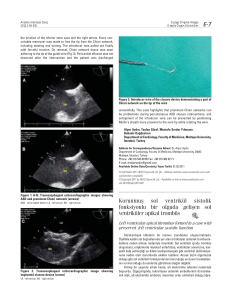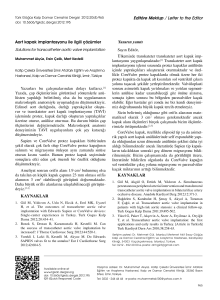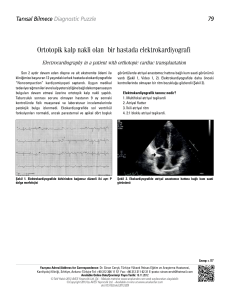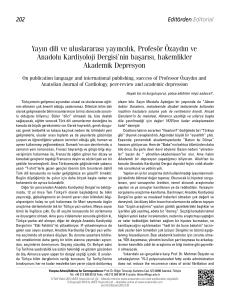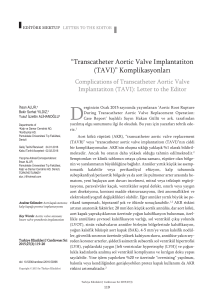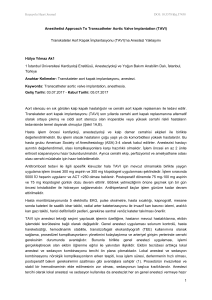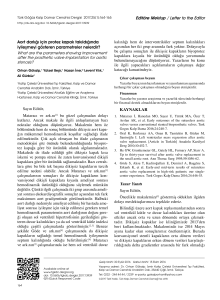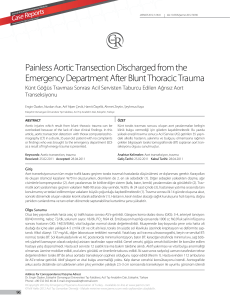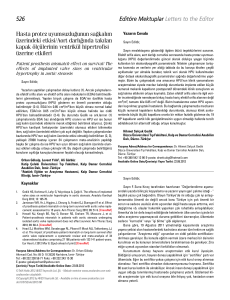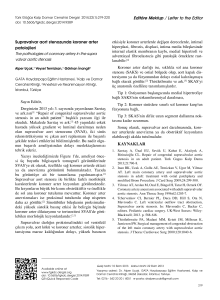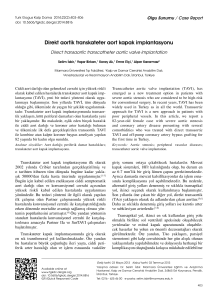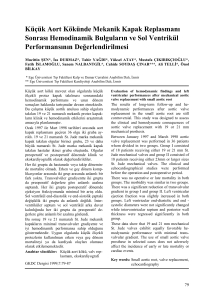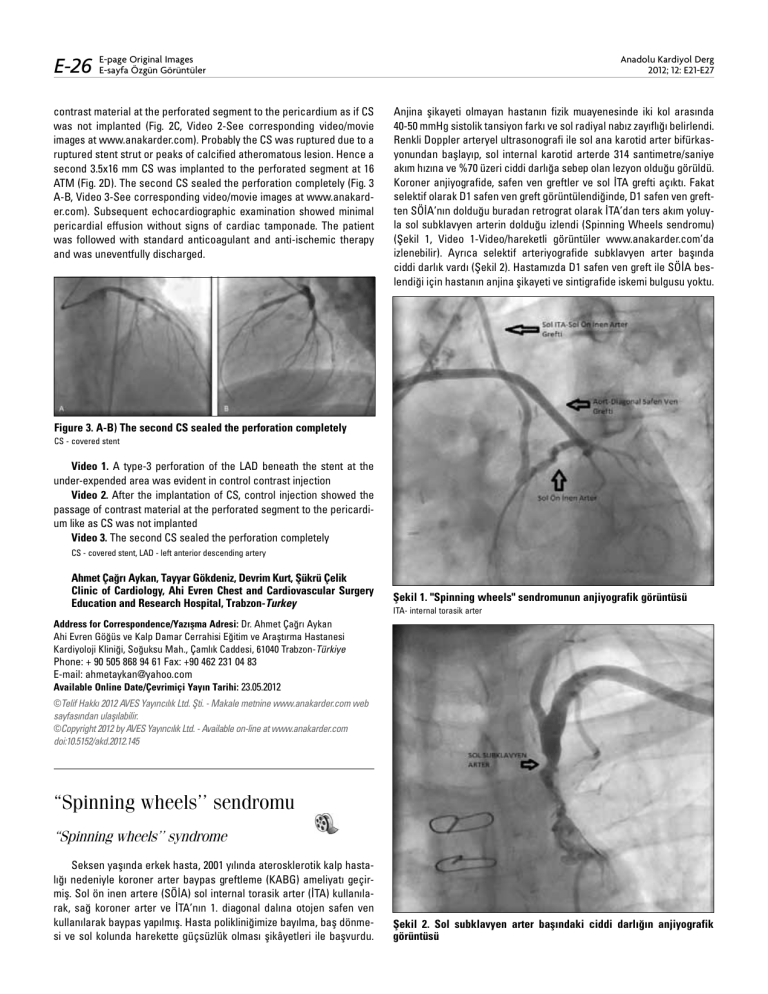
E-26
E-page Original Images
E-sayfa Özgün Görüntüler
contrast material at the perforated segment to the pericardium as if CS
was not implanted (Fig. 2C, Video 2-See corresponding video/movie
images at www.anakarder.com). Probably the CS was ruptured due to a
ruptured stent strut or peaks of calcified atheromatous lesion. Hence a
second 3.5x16 mm CS was implanted to the perforated segment at 16
ATM (Fig. 2D). The second CS sealed the perforation completely (Fig. 3
A-B, Video 3-See corresponding video/movie images at www.anakarder.com). Subsequent echocardiographic examination showed minimal
pericardial effusion without signs of cardiac tamponade. The patient
was followed with standard anticoagulant and anti-ischemic therapy
and was uneventfully discharged.
Anadolu Kardiyol Derg
2012; 12: E21-E27
Anjina şikayeti olmayan hastanın fizik muayenesinde iki kol arasında
40-50 mmHg sistolik tansiyon farkı ve sol radiyal nabız zayıflığı belirlendi.
Renkli Doppler arteryel ultrasonografi ile sol ana karotid arter bifürkasyonundan başlayıp, sol internal karotid arterde 314 santimetre/saniye
akım hızına ve %70 üzeri ciddi darlığa sebep olan lezyon olduğu görüldü.
Koroner anjiyografide, safen ven greftler ve sol İTA grefti açıktı. Fakat
selektif olarak D1 safen ven greft görüntülendiğinde, D1 safen ven greftten SÖİA’nın dolduğu buradan retrograt olarak İTA’dan ters akım yoluyla sol subklavyen arterin dolduğu izlendi (Spinning Wheels sendromu)
(Şekil 1, Video 1-Video/hareketli görüntüler www.anakarder.com’da
izlenebilir). Ayrıca selektif arteriyografide subklavyen arter başında
ciddi darlık vardı (Şekil 2). Hastamızda D1 safen ven greft ile SÖİA beslendiği için hastanın anjina şikayeti ve sintigrafide iskemi bulgusu yoktu.
Figure 3. A-B) The second CS sealed the perforation completely
CS - covered stent
Video 1. A type-3 perforation of the LAD beneath the stent at the
under-expended area was evident in control contrast injection
Video 2. After the implantation of CS, control injection showed the
passage of contrast material at the perforated segment to the pericardium like as CS was not implanted
Video 3. The second CS sealed the perforation completely
CS - covered stent, LAD - left anterior descending artery
Ahmet Çağrı Aykan, Tayyar Gökdeniz, Devrim Kurt, Şükrü Çelik
Clinic of Cardiology, Ahi Evren Chest and Cardiovascular Surgery
Education and Research Hospital, Trabzon-Turkey
Şekil 1. "Spinning wheels" sendromunun anjiyografik görüntüsü
ITA- internal torasik arter
Address for Correspondence/Yaz›şma Adresi: Dr. Ahmet Çağrı Aykan
Ahi Evren Göğüs ve Kalp Damar Cerrahisi Eğitim ve Araştırma Hastanesi
Kardiyoloji Kliniği, Soğuksu Mah., Çamlık Caddesi, 61040 Trabzon-Türkiye
Phone: + 90 505 868 94 61 Fax: +90 462 231 04 83
E-mail: [email protected]
Available Online Date/Çevrimiçi Yayın Tarihi: 23.05.2012
©Telif Hakk› 2012 AVES Yay›nc›l›k Ltd. Şti. - Makale metnine www.anakarder.com web
sayfas›ndan ulaş›labilir.
©Copyright 2012 by AVES Yay›nc›l›k Ltd. - Available on-line at www.anakarder.com
doi:10.5152/akd.2012.145
“Spinning wheels’’ sendromu
“Spinning wheels’’ syndrome
Seksen yaşında erkek hasta, 2001 yılında aterosklerotik kalp hastalığı nedeniyle koroner arter baypas greftleme (KABG) ameliyatı geçirmiş. Sol ön inen artere (SÖİA) sol internal torasik arter (İTA) kullanılarak, sağ koroner arter ve İTA’nın 1. diagonal dalına otojen safen ven
kullanılarak baypas yapılmış. Hasta polikliniğimize bayılma, baş dönmesi ve sol kolunda harekette güçsüzlük olması şikâyetleri ile başvurdu.
Şekil 2. Sol subklavyen arter başındaki ciddi darlığın anjiyografik
görüntüsü
Anadolu Kardiyol Derg
2012; 12: E21-E27
Tedavide, aynı seansta sol ana karotid arter bifürkasyonundan sol
internal karotid artere uzanan endarterektomi ve 8 mm ringli greft kullanılarak sol karotikosubklavyen baypas yapıldı. Hasta ameliyattan sonra
problemsiz olarak dördüncü gün taburcu edildi.
Spinning Wheels (çıkrık) sendromu, koroner subklavyen çalma
sendromunun değişik bir formu olarak farklı anatomik görünümlerde
karşımıza çıkabilir. Proksimal subklavyen arter darlığı ve KABG’nin birlikte bulunması nadir olmasına rağmen, KABG planlanan hastalarda
aortik arkın görüntülenmesi olası morbiditeleri önleyebilir.
Video 1. "Spinning wheels" (çıkrık) sendromunun anjiyografik video
görüntüsü
İbrahim Kara, Fatih Gümüşer*, Tekin Yıldırım
Özel Göztepe Şafak Hastanesi, Kalp ve Damar Cerrahisi ve
*Kardiyoloji Kliniği, İstanbul-Türkiye
Yaz›şma Adresi/Address for Correspondence: Dr. İbrahim Kara
Özel Göztepe Şafak Hastanesi, Kalp ve Damar Cerrahisi Kliniği, Fahrettin Kerim
Gökay Cad. No: 192, Kadıköy, İstanbul-Türkiye
E-page Original Images
E-sayfa Özgün Görüntüler
E-27
Aortotomy revealed typical ochronotic pigmentation of a severely
calcified aortic valve and aortic intima. The patient underwent aortic
valve replacement with a 25-mm aortic valve prosthesis and the left
internal mammarian to the left anterior descending artery and single
venous to the right coronary artery bypass grafting (Fig. 2, 3).
The postoperative course was uneventful. The patient was discharged on the fifth postoperative day.
This extremely rare illness, detected at the time of surgery, has only
been described in few papers in the cardiovascular surgery.
From the anesthesiologist’s point of view, there is a severe risk of
difficult airway because of an advanced stiffness of the cervical spine
and a reduced mouth opening in these patients.
From the surgeon’s point of view, there is more risk during cannulation of the ascending aorta, because the discolored aortic lesions are
usually more mobile than in other patients. In addition, after opening the
aorta and resection of the calcified aortic valve, some black calcium
particles can move into the left ventricle cavity and be invisible, so that
there is more emboli risk than in other patients.
Tel: +90 216 565 44 44-1050 Faks: +90 216 565 86 86
E-posta: [email protected]
Çevrimiçi Yayın Tarihi/Available Online Date: 23.05.2012
©Telif Hakk› 2012 AVES Yay›nc›l›k Ltd. Şti. - Makale metnine www.anakarder.com web
sayfas›ndan ulaş›labilir.
©Copyright 2012 by AVES Yay›nc›l›k Ltd. - Available on-line at www.anakarder.com
doi:10.5152/akd.2012.146
Black aorta in a patient with
alkaptonuric ochronosis
Alkaptonürik okronozis'li bir hastada siyah aort
Alcaptonuria (black urine disease) is a rare inherited genetic disorder of phenylalanine and tyrosine metabolism with hiperpigmentation
of skin, sclera, cartilages, degenerative ochronic arthropathies. Other
important consequences of alcaptonuric ochronosis are aortic valve
stenosis and urinary tract involvement.
A 62-year-old male patient with unknown alcaptonuria was admitted to our institution (Fig. 1, Typical dark spots on the sclera and a dark
skin lesion and collected urine was black). Echocardiography showed
aortic stenosis with a mean gradient of 55 mmHg. Coronary angiography
demonstrated 2-Vessel-Disease.
Figure 2. Operative view of situs and the bluish-black discoloration of
the aortic valve and the aortic intima
Figure 3. Operative specimen view of situs and the bluish-black discoloration of the aortic valve and the aortic intima
Alper Tosya, Pınar Köksal Çoşkun, Barış Uymaz, Onurcan Tarcan,
Tayfun Aybek
Department of Cardiovascular Surgery, Medical Center, TOBB
University, Ankara-Turkey
Address for Correspondence/Yaz›şma Adresi: Tayfun Aybek, MD, PhD
TOBB Üniversitesi, Tıp Merkezi, Kalp Damar Cerrahisi Bölümü
Yaşam Cad. No: 5, Söğütözü, Ankara-Türkiye
Phone: +90 312 292 98 06 Fax: +90 312 284 58 70
E-mail: [email protected]
Available Online Date/Çevrimiçi Yayın Tarihi: 23.05.2012
Figure 1. A physical examination demonstrated dark spots on the
sclera and a dark skin lesion on the left eyebrow and urine was black
if collected and especially when left standing for a period of time
©Telif Hakk› 2012 AVES Yay›nc›l›k Ltd. Şti. - Makale metnine www.anakarder.com web
sayfas›ndan ulaş›labilir.
©Copyright 2012 by AVES Yay›nc›l›k Ltd. - Available on-line at www.anakarder.com
doi:10.5152/akd.2012.147

